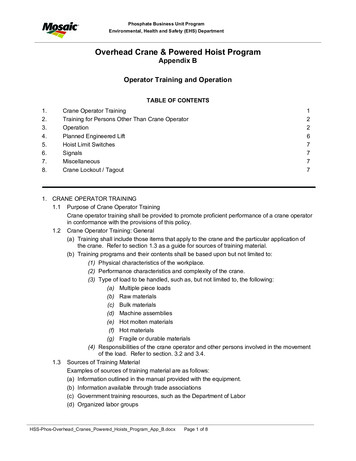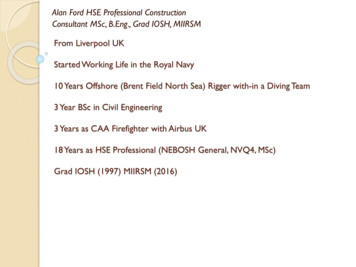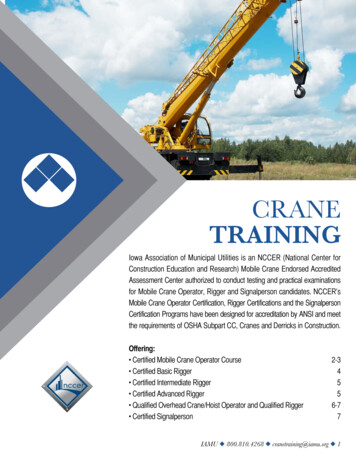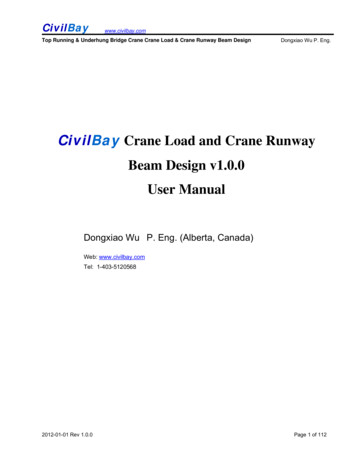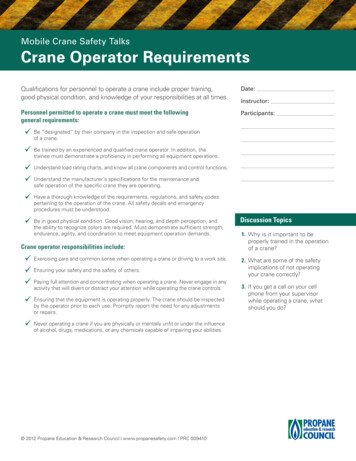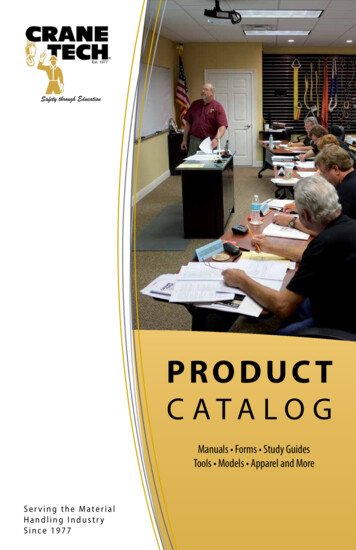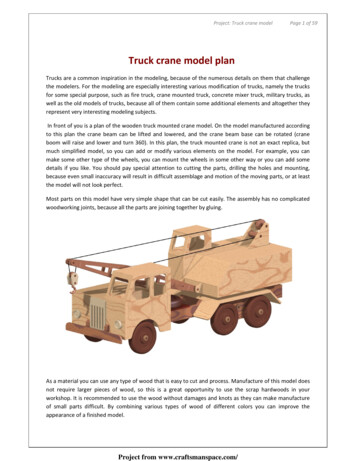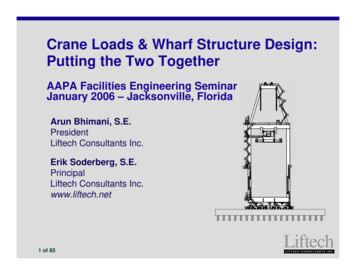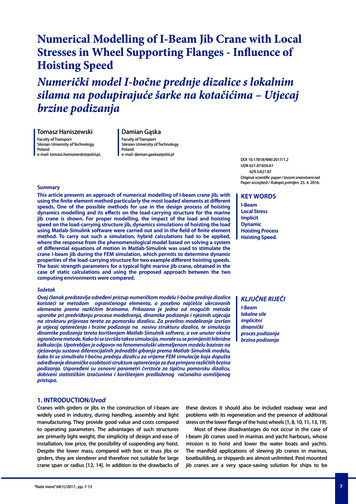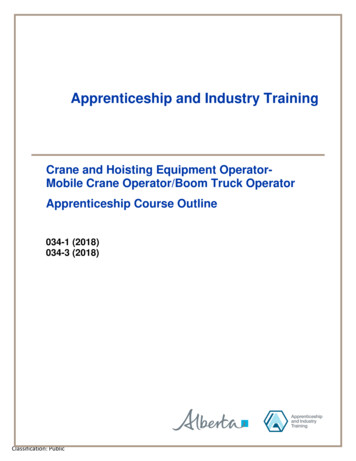
Transcription
Apprenticeship and Industry TrainingCrane and Hoisting Equipment OperatorMobile Crane Operator/Boom Truck OperatorApprenticeship Course Outline034-1 (2018)034-3 (2018)Classification: Public
ALBERTA ADVANCED EDUCATIONCrane and Hoisting Equipment Operator - Mobile Crane Operator/Boom Truck Operator Course OutlineISBN 978-1-4601-3825-0 (PDF)ALL RIGHTS RESERVED: 2018, Her Majesty the Queen in right of the Province of Alberta, as represented by the Minister of Advanced Education,10th floor, Commerce Place, Edmonton, Alberta, Canada, T5J 4L5. All rights reserved. No part of this material may bereproduced in any form or by any means, without the prior written consent of the Minister of Advanced Education Province ofAlberta, Canada.Classification: Public
Crane and Hoisting Equipment Operator – Mobile Crane/Boom TruckTable of ContentsCrane and Hoisting Equipment Operator – Mobile Crane/Boom Truck Table of Contents . 1Apprenticeship . 2Apprenticeship and Industry Training System . 2Apprenticeship Safety . 4Procedures for Recommending Revisions to the Course Outline . 5Apprenticeship Route toward Certification . 6Crane and Hoisting Equipment Operator – Mobile Crane/Boom Truck Training Profile . 7Course OutlineFirst Period Technical Training . 10Third Period Technical Training. 17Classification: Public-1-
ApprenticeshipApprenticeship is post-secondary education with a difference. Apprenticeship begins with finding an employer.Employers hire apprentices, pay their wages and provide on-the-job training and work experience. Approximately80 per cent of an apprentice’s time is spent on the job under the supervision of a certified journeyperson orqualified tradesperson. The other 20 per cent involves technical training provided at, or through, a postsecondary institution – usually a college or technical institute.To become certified journeypersons, apprentices must learn theory and skills, and they must pass examinations.Requirements for certification—including the content and delivery of technical training—are developed andupdated by the Alberta Apprenticeship and Industry Training Board on the recommendation of Crane and HoistingEquipment Operator Provincial Apprenticeship Committee.The graduate of the Mobile Crane/Boom Truck apprenticeship program is a certified journeyperson who will beable to: maintain tools and equipment.demonstrate safe work practices.recognize and mitigate hazardous conditions related to boom truck/mobile crane operation.interpret and apply load charts, manufacturers manual and other related documentation.apply reference use, management and organizational skills.set-up boom truck/mobile crane for a lift.rig the load for lifting.hoist as per signals.operate the boom truck/mobile crane to lift and set the loadprepare the boom truck/mobile crane for travel.understand the fundamentals of operating a small business.perform assigned tasks in accordance with quality and production standards required by industry.Apprenticeship and Industry Training SystemIndustry-DrivenAlberta’s apprenticeship and industry training system is an industry-driven system that ensures a highly skilled,internationally competitive workforce in more than 50 designated trades and occupations. This workforce supportsthe economic progress of Alberta and its competitive role in the global market. Industry (employers andemployees) establishes training and certification standards and provides direction to the system through anindustry committee network and the Alberta Apprenticeship and Industry Training Board. The Alberta governmentprovides the legislative framework and administrative support for the apprenticeship and industry training system.Alberta Apprenticeship and Industry Training BoardThe Alberta Apprenticeship and Industry Training Board provides a leadership role in developing Alberta’s highlyskilled and trained workforce. The Board’s primary responsibility is to establish the standards and requirementsfor training and certification in programs under the Apprenticeship and Industry Training Act. The Board alsoprovides advice to the Minister of Advanced Education on the needs of Alberta’s labour market for skilled andtrained workers, and the designation of trades and occupations.The thirteen-member Board consists of a chair, eight members representing trades and four membersrepresenting other industries. There are equal numbers of employer and employee representatives.Industry Committee NetworkAlberta’s apprenticeship and industry training system relies on a network of industry committees, including localand provincial apprenticeship committees in the designated trades, and occupational committees in thedesignated occupations. The network also includes other committees such as provisional committees that areestablished before the designation of a new trade or occupation comes into effect. All trade committees arecomposed of equal numbers of employer and employee representatives. The industry committee network is thefoundation of Alberta’s apprenticeship and industry training system.-2-Classification: Public
Local Apprenticeship Committees (LAC)Wherever there is activity in a trade, the Board can set up a local apprenticeship committee. The Board appointsequal numbers of employee and employer representatives for terms of up to three years. The committeeappoints a member as presiding officer. Local apprenticeship committees: monitor apprenticeship programs and the progress of apprentices in their trade, at the local level make recommendations to their trade’s provincial apprenticeship committee (PAC) about apprenticeshipand certification in their trade promote apprenticeship programs and training and the pursuit of careers in their trade make recommendations to the Board about the appointment of members to their trade’s PAC help settle certain kinds of disagreements between apprentices and their employers carry out functions assigned by their trade’s PAC or the BoardProvincial Apprenticeship Committees (PAC)The Board establishes a provincial apprenticeship committee for each trade. It appoints an equal number ofemployer and employee representatives, and, on the PAC’s recommendation, a presiding officer - each for amaximum of two terms of up to three years. Most PACs have nine members but can have as many as twentyone. Provincial apprenticeship committees: make recommendations to the Board about: standards and requirements for training and certification in their trade courses and examinations in their trade apprenticeship and certification designation of trades and occupations regulations and orders under the Apprenticeship and Industry Training Act monitor the activities of local apprenticeship committees in their trade determine whether training of various kinds is equivalent to training provided in an apprenticeshipprogram in their trade promote apprenticeship programs and training and the pursuit of careers in their trade consult with other committees under the Apprenticeship and Industry Training Act about apprenticeshipprograms, training and certification and facilitate cooperation between different trades and occupations consult with organizations, associations and people who have an interest in their trade and withemployers and employees in their trade may participate in resolving certain disagreements between employers and employees carry out functions assigned by the BoardCrane and Hoisting Equipment Operator PAC Members at Time of PublicationMr. S. Fryer . Edmonton . Presiding OfficerMr. S. Gibson . Ft. Saskatchewan. EmployerMr. J. Kidd . Ft. McMurray . EmployerMr. D. Secord . Spruce Grove . EmployerMr. T. Tessier . Calgary . EmployerMr. M. Iliffe. Devon . EmployeeMr. D. Stanley. Calgary . EmployeeMr. M. Stokes . Beaumont . EmployeeAlberta GovernmentAlberta Advanced Education works with industry, employer and employee organizations and technical trainingproviders to: facilitate industry’s development and maintenance of training and certification standards provide registration and counselling services to apprentices and employers coordinate technical training in collaboration with training providers certify apprentices and others who meet industry standards-3-Classification: Public
Apprenticeship SafetySafe working procedures and conditions, incident/injury prevention, and the preservation of health are of primaryimportance in apprenticeship programs in Alberta. These responsibilities are shared and require the joint effortsof government, employers, employees, apprentices and the public. Therefore, it is imperative that all parties areaware of circumstances that may lead to injury or harm.Safe learning experiences and healthy environments can be created by controlling the variables and behavioursthat may contribute to or cause an incident or injury. By practicing a safe and healthy attitude, everyone canenjoy the benefit of an incident and injury free environment.Alberta Apprenticeship and Industry Training Board Safety PolicyThe Alberta Apprenticeship and Industry Training Board (board) fully supports safe learning and workingenvironments and emphasizes the importance of safety awareness and education throughout apprenticeshiptraining- in both on-the- job training and technical training. The board also recognizes that safety awareness andeducation begins on the first day of on-the-job training and thereby is the initial and ongoing responsibility of theemployer and the apprentice as required under workplace health and safety training. However the boardencourages that safe workplace behaviour is modeled not only during on-the-job training but also during allaspects of technical training, in particular, shop or lab instruction. Therefore the board recognizes that safetyawareness and training in apprenticeship technical training reinforces, but does not replace, employer safetytraining that is required under workplace health and safety legislation.The board has established a policy with respect to safety awareness and training:The board promotes and supports safe workplaces, which embody a culture of safety for allapprentices, employers and employees.Employer required safety training is theresponsibility of the employer and the apprentice, as required under legislation other thanthe Apprenticeship and Industry Training Act.The board’s complete document on its ‘Apprenticeship Safety Training Policy’ is available atwww.tradesecrets.alberta.ca; access the website and conduct a search for ‘safety training policy’.Implementation of the policy includes three common safety learning outcomes and objectives for all trade courseoutlines. These common learning outcomes ensure that each course outline utilizes common language consistentwith workplace health and safety terminology. Under the title of ‘Standard Workplace Safety’, this first section ofeach trade course outline enables the delivery of generic safety training; technical training providers will providetrade specific examples related to the content delivery of course outline safety training.Occupational Health and SafetyA tradesperson is often exposed to more hazards than any other person in the work force and therefore should befamiliar with and apply the Occupational Health and Safety Act, Regulations and Code when dealing withpersonal safety and the special safety rules that apply to all daily tasks.Occupational Health and Safety (A division of Alberta Human Services) conducts periodic inspections ofworkplaces to ensure that safety regulations for industry are being observed.Additional information is available at www.humanservices.alberta.ca-4-Classification: Public
Technical TrainingApprenticeship technical training is delivered by the technical institutes and colleges in the public post-secondarysystem throughout Alberta. The colleges and institutes are committed to delivering the technical trainingcomponent of Alberta apprenticeship programs in a safe, efficient and effective manner. All training providersplace a strong emphasis on safety that complements safe workplace practices towards the development of aculture of safety for all trades.The technical institutes and colleges work with Alberta’s Apprenticeship and Industry Training Board, industrycommittees and Alberta Advanced Education to enhance access and responsiveness to industry needs throughthe delivery of the technical training component of apprenticeship programs across the Province. They developcurriculum from the course outlines established by industry and provide technical training to apprentices.The following technical training providers deliver trade name apprenticeship training:Northern Alberta Institute of TechnologyNorthern Lakes College(NAIT)Southern Alberta Institute of Technology(SAIT)Keyano CollegeProcedures for Recommending Revisions to the Course OutlineAdvanced Education has prepared this course outline in partnership with the trade name ProvincialApprenticeship Committee.This course outline was approved on December 15, 2017 by the Alberta Apprenticeship and Industry TrainingBoard on a recommendation from the Provincial Apprenticeship Committee. The valuable input provided byrepresentatives of industry and the institutions that provide the technical training is acknowledged.Any concerned individual or group in the province of Alberta may make recommendations for change by writingto:Crane and Hoisting Equipment Operator Provincial Apprenticeship Committeec/o Industry Programs and StandardsApprenticeship and Industry TrainingAdvanced Education10th floor, Commerce Place10155 102 Street NWEdmonton AB T5J 4L5It is requested that recommendations for change refer to specific areas and state references used.Recommendations for change will be placed on the agenda for regular meetings of the Crane and HoistingEquipment Operator Provincial Apprenticeship Committee.-5-Classification: Public
Apprenticeship Route toward CertificationAPPLICATIONCONTRACT AND RECORD BOOKENTRANCE OOF OFEDUCATIONALPREREQUISTEFAILPASSCHEO – Boom TruckCHEO – Mobile CraneFIRST PERIOD1620 HOURS – AND SUCCESSFULLYCOMPLETE TECHNICAL TRAININGCOMMONCOREFIRST PERIOD1020 HOURS – AND SUCCESSFULLYCOMPLETE TECHNICAL TRAININGSECOND PERIOD1800 HOURSNO TECHNICAL TRAININGTHIRD PERIOD1620 HOURS – AND SUCCESSFULLYCOMPLETE TECHNICAL TRAININGJOURNEYMAN CERTIFICATE –CHEO – BOOM TRUCKJOURNEYMAN CERTIFICATECHEO – MOBILE CRANEINTERPROVINCIAL EXAMINATION FOR ‘RED SEAL’-6-Classification: Public
Crane and Hoisting Equipment OperatorMobile Crane Operator / Boom Truck OperatorFIRST PERIOD – Common Core(6 Weeks 30 Hours per Week – Total of 180 Hours)SECTION ONESTANDARD WORKPLACESAFETY, MATERIALS ANDTOOLS ABCSafety Legislation,Regulations & Industry Policyin the TradesClimbing, Lifting, Rigging andHoistingHazardous Materials andFire Protection24 HOURS3 Hours5 HoursDEApprenticeship TrainingProgramCodes and Regulations1 HoursSECTION TWOINTRODUCTION TO BOOMTRUCKS AND CRANES, CODESAND DOCUMENTATION22 HOURS 12 HoursABCTypes of Boom TrucksBoom Truck ComponentsTypes of Mobile Cranes2 Hours2 HoursRIGGING EQUIPMENT ANDPROCEDURES EFMobile Crane ComponentsHoisting EquipmentMaintenanceDocumentation10 HoursBCTypes of SlingsRigging Hardware andAccessoriesRigging Calculations2 Hours2 HoursDERigging ProceduresCrane Signals andCommunication6 Hours18 Hours12 HoursALOAD CHART READING ANDINTERPRETATION Load Charts30 HOURS30 HoursSECTION FIVEEQUIPMENT OPERATION ABCEquipment TransportationSite PreparationLoading and UnloadingEquipment40 HOURS2 Hours2 HoursDEAssembly and Disassemblyof Hoisting EquipmentEquipment Set Up3 Hours2 HoursFPrinciples of Operation12 Hours2 HoursGHILift PlanningLift OperationsLeaving Crane Unattended6 Hours-7-Classification: Public2 HoursA40 HOURSSECTION FOUR2 HoursD4 HoursSECTION THREE3 Hours10 Hours1 Hour
SECTION SIXSPECIALTY LIFTS AND NEWTECHNOLOGY, WORKPLACECOACHING, ALBERTA’SINDUSTRY NETWORK ABCMulti-Crane LiftsPersonnel BasketsNew Technology24 HOURS10 HoursEWorkplace Coaching SkillsAlberta’s Industry Network3 Hours-8-Classification: Public6 HoursD1 Hour4 Hours
THIRD PERIOD – Mobile Crane Operator(6 Weeks 30 Hours per Week – Total of 180 Hours)SECTION ONELATTICE BOOM CRANES ABCTypes of Lattice BoomCranesLattice Boom ComponentsLattice Boom Inspectionand Maintenance22 HOURS4 Hours6 Hours6 HoursDMobile Telescopic Cranes6 HoursSECTION TWOCRANE ATTACHMENTS ANDCRANE ASSEMBLY ABCJibsHeavy Lift AttachmentsSpecialty Accessories33 HOURS3 Hours6 HoursEFSite PreparationLoading and UnloadingCranes and ComponentsCrane Assembly andDisassembly6 HoursSECTION THREE ADVANCED RIGGINGADVANCED LIFT PLANNINGAND OPERATION CSpecialty Rigging EquipmentAdvanced RiggingProceduresAdvanced RiggingCalculations6 HoursBCCritical Lift PlanningMulti-Crane LiftsSingle Crane Operations10 Hours 20 HoursA60 HOURS33 HOURS10 HoursB6 HoursSECTION FIVELOAD CHART, LIFTINGOPERATIONS, RED SEAL6 HoursA32 HOURSSECTION FOUR2 HoursD25 Hours25 HoursABCAdvanced Load ChartInterpretingLift DynamicsInterprovincial StandardsRed Seal Program25 Hours6 Hours2 HoursNOTE: The hours stated are for guidance and should be adhered to as closely as possible. However,adjustments must be made for rate of apprentice learning, statutory holidays, registration and examinations forthe training establishment and Apprenticeship and Industry Training.-9-Classification: Public
FIRST PERIOD TECHNICAL TRAINING – COMMON CORECRANE AND HOISTING EQUIPMENT OPERATOR – MOBILE CRANE OPERATOR TRADE/BOOM TRUCK OPERATOR TRADECOURSE OUTLINEUPON SUCCESSFUL COMPLETION OF THIS PROGRAM THE APPRENTICE SHOULD BE ABLE TOPERFORM THE FOLLOWING OUTCOMES AND OBJECTIVES.SECTION ONE: . STANDARD WORKPLACE SAFETY, MATERIALS & TOOLS .24 HOURSA.Safety Legislation, Regulations & Industry Policy in the Trades . 3 HoursOutcome:B.1.Demonstrate the application of the Occupational Health and Safety Act, Regulation and Code.2.Describe the employer’s and employee’s role with Occupational Health and Safety (OH&S)regulations, Worksite Hazardous Materials Information Systems (WHMIS), fire regulations,Workers Compensation Board regulations and related advisory bodies and agencies.3.Describe industry practices for hazard assessment and control procedures.4.Describe the responsibilities of worker and employers to apply emergency procedures.5.Describe tradesperson attitudes with respect to housekeeping, personal protective equipmentand emergency procedures.6.Describe the roles and responsibilities of employers and employees with the selection and useof personal protective equipment (PPE).7.Maintain required PPE for tasks.8.Use required PPE for tasks.Climbing, Lifting, Rigging and Hoisting. 5 HoursOutcome:C.Apply legislation, regulations and practices ensuring safe work in this trade.Use industry standard practices for climbing, lifting, rigging and hoisting in thistrade.1.Describe manual lifting procedures.2.Describe rigging hardware and associated safety factors.3.Select equipment for rigging loads.4.Describe hoisting and load moving procedures.5.Maintain personal protective equipment (PPE) for climbing, lifting and load moving equipment.6.Use PPE for climbing, lifting and load moving equipment.Hazardous Materials & Fire Protection . 3 HoursOutcome:Apply industry standard practices for hazardous materials and fire protection inthis trade.1.Describe roles, responsibilities, features and practices related to the Workplace HazardousMaterials Information System (WHMIS) program.2.Describe three key elements of WHMIS.3.Describe handling, storing and transporting procedures for hazardous material.4.Describe venting procedures when working with hazardous materials.5.Describe hazards, classes, procedures and equipment related to fire protection.- 10 -Classification: Public
FIRST PERIODD.Apprenticeship Training Program . 1 HourOutcome:E.Manage an apprenticeship to earn journeyman certification.1.Describe the contractual responsibilities of the apprentice, employer and AlbertaApprenticeship and Industry Training.2.Describe the purpose of the apprentice record book.3.Describe the procedure for changing employers during an active apprenticeship.4.Describe the purpose of the course outline.5.Describe the procedure for progressing through an apprenticeship.6.Describe advancement opportunities in this trade.Codes and Regulations . 12 HoursOutcome:Interpret codes and regulations.1.Explain Alberta’s trade regulations for the crane and hoisting equipment operator trade.2.Explain transportation rules and regulations.3.Identify the sections of Occupational Health and Safety code that apply to hoisting equipment.4.Interpret codes and standards for hoisting equipment.SECTION TWO: . INTRODUCTION TO BOOM TRUCKS AND CRANES .22 HOURSA.Types of Boom Trucks . 2 HoursOutcome:B.1.Describe fixed station telescopic boom trucks.2.Describe swing cab telescopic boom trucks.3.Describe articulating boom trucks.Boom Truck Components. 2 HoursOutcome:C.Identify the structural and operational characteristics of boom trucks.Describe boom truck components.1.Describe the truck chassis.2.Describe outriggers and stabilizers.3.Describe the upperworks of a boom truck.Types of Mobile Crane . 2 HoursOutcome:Identify the structural and operational characteristics of mobile cranes.1.Describe carry deck cranes.2.Describe rough terrain cranes.3.Describe all terrain cranes.4.Describe truck mounted cranes.5.Describe crawler mounted cranes.6.Describe lattice boom cranes.- 11 -Classification: Public
FIRST PERIODD.Mobile Crane Components . 4 HoursOutcome:E.1.Describe wheeled carriers.2.Describe crawler carriers.3.Describe upperworks of mobile cranes.4.Describe the composition and characteristics of wire rope.Hoisting Equipment Maintenance . 10 HoursOutcome:F.Describe mobile crane components.Maintain hoisting equipment.1.Describe tools used to assemble and maintain hoisting equipment.2.Identify maintenance on engines.3.Identify maintenance on hydraulic systems.4.Identify maintenance on air systems.5.Identify maintenance on mechanical components and structures.6.Identify maintenance on electrical systems.7.Describe the types and characteristics of lubricant.8.Identify the lubrication points on each components.Documentation . 2 HoursOutcome:Complete documentation.1.Complete a daily crane log book.2.Complete maintenance request form.3.Complete a hazard assessment.SECTION THREE: . RIGGING EQUIPMENT AND PROCEDURES .40 HOURSA.Types of Slings . 2 HoursOutcome:B.Describe the types and functions of slings.1.Describe slings used for rigging loads.2.Describe Working Load Limits (WLL) for slings.3.Interpret codes for slings and accessories.4.Describe rigging configurations.5.Describe the inspection of slings.6.Describe rejection criteria for slings.7.Describe the storage and maintenance of slings.Rigging Hardware and Accessories . 2 HoursOutcome:Describe types and functions of rigging hardware and accessories.1.Describe the use of rigging hardware.2.Describe the use of rigging accessories.- 12 -Classification: Public
FIRST PERIODC.Rigging Calculations . 18 HoursOutcome:D.1.Define capacities for configurations.2.Determine capacity reducing factors.Rigging Procedures . 6 HoursOutcome:E.Calculate rigging capacities.Rig loads.1.Explain characteristics of a load.2.Determine center of gravity of the load.3.Determine load weight.4.Determine rigging configuration.5.Rig the load.Crane Signals and Communication . 12 HoursOutcome:Signal the crane.1.Perform crane hand signals.2.Perform verbal signals.SECTION FOUR: . LOAD CHART READING AND INTERPRETATION .30 HOURSA.Load Charts . 30 HoursOutcome:Interpret load charts for hoisting equipment.1.Determine gross and net load.2.Determine gross and net capacities.3.Determine percentage of gross capacity.4.Perform load chart calculations.5.Interpret range diagrams.6.Analyze an engineered lift plan.7.Define the parameters of a lift.- 13 -Classification: Public
FIRST PERIODSECTION FIVE: . EQUIPMENT OPERATION .40 HOURSA.Equipment Transportation. 2 HoursOutcome:B.1.Explain transportation regulations for hoisting equipment in Alberta.2.Determine manufacturer’s transportation procedures.Site Preparation . 2 HoursOutcome:C.Recognize ground site conditions.2.Identify site hazards (powerlines, underground utilities, buildings).3.Calculate ground bearing pressure.4.Determine space requirements for assembly and disassembly.5.Determine space requirements for lifting operations.Loading and Unloading Hoisting Equipment . 2 HoursDetermine orientation of the crane on the trailer.2.Determine crane configuration.3.Describe loading and unloading procedures.4.Describe crane and component tie down procedures.Assembly and Disassembly of Hoisting Equipment . 3 HoursConfigure hoisting equipment components.1.Identify crane components.2.Describe the function of crane components.3.Describe the assembly of a jib to manufactures specifications.4.Demonstrate wire rope block reeving methods.5.Perform a pre-operational inspection.Equipment Set-Up . 12 HoursOutcome:F.Describe loading and unloading hoisting equipment.1.Outcome:E.Prepare site for hoisting equipment.1.Outcome:D.Prepare crane for travel on public roads and site.Set-up hoisting equipment.1.Perform pre-operational inspection.2.Set-up and level hoisting equipment.3.Configure the hoisting equipment.4.Function test all controls and limit switches.Principles of Operation . 2 HoursOutcome:Describe the principles of operation.1.Describe the principles of leverage.2.Describe load moment.- 14 -Classification: Public
FIRST PERIODG.3.Explain center of gravity.4.Explain the mechanical advantage reeving.5.Describe stability versus structural capacity.6.Describe quadrants of operation.7.Describe dynamic and static loading.8.Describe the effect of the load on the hoisting equipment.9.Describe the effects of various forces on the hoisting equipment.Lift Planning .
Apprenticeship and Industry Training Crane and Hoisting Equipment Operator- . ALBERTA ADVANCED EDUCATION Crane and Hoisting Equipment Operator - Mobile Crane Operator/Boom Truck Operator Course Outline ISBN 978-1-4601-3825- (PDF) ALL RIGHTS RESERVED: . manufacturers manual and other related documentation. apply reference use, management .
